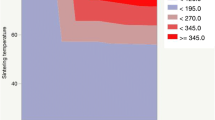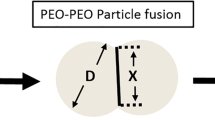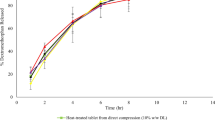Abstract
The objective of the present study is to understand the effects of drug-PEO interactions during the thermal treatment of polyethylene oxide (PEO)-based, directly compressed, abuse-deterrent formulations (ADFs). The drugs studied were dextromethorphan HBr monohydrate, ketoprofen, promethazine HCl, and anhydrous theophylline. Thermal treatment above the melting point of PEO resulted in tablets with higher crushing strength (> 500 N). It was observed that drug-PEO interactions during thermal treatment (80°C) led to solubilization of the incorporated drug. Drugs with higher solubility in the molten PEO, when added at higher weight fractions, interfered with the process of tablet densification which led to an increase in tablet dimensions and created defects in the fused matrix. These changes resulted in the formation of a more porous matrix. Thermal treatment led to a decrease in PEO crystallinity. The decreased crystallinity led to differences in the hydration and dissolution properties of the PEO. The change in dissolution properties of PEO accompanied with the dimensional and microstructural changes resulted in a greater drug release for some of the studied drugs. In conclusion, although thermal treatment above the melting point of PEO is an efficient manufacturing process in imparting crush-resistant features, drug-PEO interactions during the thermal treatment and the impact of thermal treatment on the properties of formulation components may impact tablet properties and lead to potential performance differences.





Similar content being viewed by others
References
Rudd RA, Seth P, David F, Scholl L. Increases in drug and opioid-involved overdose deaths—United States, 2010–2015. MMWR Morb Mortal Wkly Rep. 2016;65:1445–52. https://doi.org/10.15585/mmwr.mm655051e1.
Lessenger JE, Feinberg SD. Abuse of prescription and over-the-counter medications. J Am Board Fam Med. 2008;21(1):45–54. https://doi.org/10.3122/jabfm.2008.01.070071.
Compton WM, Volkow ND. Abuse of prescription drugs and the risk of addiction. Drug Alcohol Depend. 2006;83:S4–7. https://doi.org/10.1016/j.drugalcdep.2005.10.020.
Katz N, Dart RC, Bailey E, Trudeau J, Osgood E, Paillard F. Tampering with prescription opioids: nature and extent of the problem, health consequences, and solutions. Am J Drug Alcohol Abuse. 2011;37(4):205–17. https://doi.org/10.3109/00952990.2011.569623.
Mastropietro DJ, Omidian H. Current approaches in tamper-resistant and abuse-deterrent formulations. Drug Dev Ind Pharm. 2013;39(5):611–24. https://doi.org/10.3109/03639045.2012.680468.
Katz N. Abuse-deterrent opioid formulations: are they a pipe dream? Curr Rheumatol Rep. 2008;10(1):11–8. https://doi.org/10.1007/s11926-008-0003-z.
Mastropietro DJ, Omidian H. Abuse-deterrent formulations: part 1 – development of a formulation-based classification system. Expert Opin Drug Metab Toxicol. 2015;11(2):193–204. https://doi.org/10.1517/17425255.2015.979786.
Herry C, Monti A, Vauzelle-Kervroedan F, Oury P, Michel L. Reducing abuse of orally administered prescription opioids using formulation technologies. J Drug Deliv Sci Technol. 2013;23(2):103–10.
Webster LR, Markman J, Cone EJ, Niebler G. Current and future development of extended-release, abuse-deterrent opioid formulations in the United States. Postgrad Med J. 2017;129(1):102–10. https://doi.org/10.1080/00325481.2017.1268902.
Maincent J, Zhang F. Recent advances in abuse-deterrent technologies for the delivery of opioids. Int J Pharm. 2016;510(1):57–72. https://doi.org/10.1016/j.ijpharm.2016.06.012.
Muppalaneni S, Mastropietro DJ, Omidian H. Crush resistance and insufflation potential of poly(ethylene oxide)-based abuse deterrent formulations. Expert Opin Drug Deliv. 2016;13(10):1375–82. https://doi.org/10.1080/17425247.2016.1211638.
Royce AE. Directly compressible polyethylene oxide vehicle for preparing therapeutic dosage forms. United States Patent US. 1993; 5,273,758.
Bartholomaeus JH, Arkenau-Marić E, Galia E. Opioid extended-release tablets with improved tamper-resistant properties. Expert Opin Drug Deliv. 2012;9(8):879–91.
Mastropietro DJ, Omidian H. Abuse-deterrent formulations: part 2: commercial products and proprietary technologies. Expert Opin Pharmacother. 2015;16(3):305–23. https://doi.org/10.1517/14656566.2014.970175.
Ma L, Deng L, Chen J. Applications of poly (ethylene oxide) in controlled release tablet systems: a review. Drug Dev Ind Pharm. 2014;40(7):845–51. https://doi.org/10.3109/03639045.2013.831438.
Rahman Z, Yang Y, Korang-Yeboah M, Siddiqui A, Xu X, Ashraf M, et al. Assessing impact of formulation and process variables on in-vitro performance of directly compressed abuse deterrent formulations. Int J Pharm. 2016;502(1–2):138–50. https://doi.org/10.1016/j.ijpharm.2016.02.029.
Upadhye SB, Properties R-SAR. Applications of polyethylene oxide and Ethylcellulose for tamper resistance and controlled drug delivery. In: Repka MA, Langley N, DiNunzio J, editors. Melt extrusion: materials, technology and drug product design. New York, NY: Springer New York; 2013. p. 145–58.
Storrow AB, Magoon MR, Norton J. The dextromethorphan defense: dextromethorphan and the opioid screen. Acad Emerg Med. 1995;2(9):791–4. https://doi.org/10.1111/j.1553-2712.1995.tb03273.x.
Dextromethorphan HBr solubility. Available from: https://www.accessdata.fda.gov/drugsatfda_docs/nda/2010/021879Orig1s000ChemR.pdf. Accessed 14 Sept 2018.
Dextromethorphan HBr melting point. Available from: https://www.scbt.com/scbt/product/dextromethorphan-hydrobromide-125-69-9. Accessed 14 Sept 2018.
Ketoprofen solubility and melting point. Available from: National Center for Biotechnology Information. PubChem Compound Database; CID=3825, https://pubchem.ncbi.nlm.nih.gov/compound/3825. Accessed 14 Sept 2018.
Promethazine HCl solubility. Available from: http://www.selleckchem.com/datasheet/promethazine-hcl-DataSheet.html. Accessed 14 Sept 2018.
Promethazine HCl melting point. Available from: National Center for Biotechnology Information. PubChem Compound Database; CID=6014, https://pubchem.ncbi.nlm.nih.gov/compound/6014. Accessed 2 Oct 2018.
Theophylline solubility and melting point. Available from: National Center for Biotechnology Information. PubChem Compound Database; CID=2153, https://pubchem.ncbi.nlm.nih.gov/compound/2153. Accessed 14 Sept 2018.
Dextromethorphan HBr decomposition temperature. Available from: https://www.spectrumchemical.com/MSDS/D3100.pdf. Accessed 14 Sept 2018.
Wesolowski M, Szynkaruk P. Thermal decomposition of methylxanthines. J Therm Anal Calorim. 2008;93(3):739–46. https://doi.org/10.1007/s10973-008-9138-4.
Tiţa D, Fuliaş A, Tiţa B. Thermal stability of ketoprofen. J Therm Anal Calorim. 2013;111(3):1979–85. https://doi.org/10.1007/s10973-011-2147-8.
Achar B, Ashok M. Solid state electrical conductivity and thermal degradation studies on some phenothiazine derivatives. J Phys Chem Solids. 2007;68(2):175–81. https://doi.org/10.1016/j.jpcs.2006.10.006.
Colacio-Rodriguez E, Salas-Peregrin J, Ruiz-Sanchez J, Garcia-Mejias E. Thermal studies on purine complexes. IX. Palladium (II) complexes with 8-alkyl substituted theophyllines. Thermochim Acta. 1985;89:159–64. https://doi.org/10.1016/0040-6031(93)85035-8.
Tiţa D, Fuliaş A, Tiţa B. Thermal stability of ketoprofen—active substance and tablets. J Therm Anal Calorim. 2011;105(2):501–8. https://doi.org/10.1007/s10973-010-1187-9.
Consultation documents. Dextromethorphani hydrobromidum. Dextromethorphan HBr decomposition temperature. Available from: World Health Organization. https://www.who.int/medicines/areas/quality_safety/quality_assurance/2014-05-23Revision_DextromethorphanHBr-QAS14-585_22052014.pdf. Accessed 14 Sept 2018.
Nijenhuis A, Colstee E, Grijpma D, Pennings A. High molecular weight poly (L-lactide) and poly (ethylene oxide) blends: thermal characterization and physical properties. Polymer. 1996;37(26):5849–57. https://doi.org/10.1016/S0032-3861(96)00455-7.
Mura P, Manderioli A, Bramanti G, Furlanetto S, Pinzauti S. Utilization of differential scanning calorimetry as a screening technique to determine the compatibility of ketoprofen with excipients. Int J Pharm. 1995;119(1):71–9. https://doi.org/10.1016/0378-5173(94)00374-E.
Malaj L, Censi R, Mozzicafreddo M, Pellegrino L, Angeletti M, Gobetto R, et al. Influence of relative humidity on the interaction between different aryl propionic acid derivatives and poly (vinylpyrrolydone) K30: evaluation of the effect on drug bioavailability. Int J Pharm. 2010;398(1–2):61–72. https://doi.org/10.1016/j.ijpharm.2010.07.024.
Suzuki E, Shimomura K, Sekiguchi K. Thermochemical study of theophyline and its hydrate. Chem Pharm Bull. 1989;37(2):493–7. https://doi.org/10.1248/cpb.37.493.
Thumma S, Repka M. Compatibility studies of promethazine hydrochloride with tablet excipients by means of thermal and non-thermal methods. Die Pharmazie-an international. J Pharm Sci. 2009;64(3):183–9. https://doi.org/10.1691/ph.2009.8268.
Boyce H, Smith D, Byrn S, Saluja B, Qu W, Gurvich VJ, et al. In vitro assessment of nasal insufflation of comminuted drug products designed as abuse deterrent using the vertical diffusion cell. AAPS PharmSciTech. 2018;19(4):1744–57. https://doi.org/10.1208/s12249-017-0947-2.
Xu X, Gupta A, Al-Ghabeish M, Calderon SN, Khan MA. Risk based in vitro performance assessment of extended release abuse deterrent formulations. Int J Pharm. 2016;500(1–2):255–67. https://doi.org/10.1016/j.ijpharm.2016.01.031.
Rao M, Ranpise A, Borate S, Thanki K. Mechanistic evaluation of the effect of sintering on Compritol® 888 ATO matrices. AAPS PharmSciTech. 2009;10(2):355–60. https://doi.org/10.1208/s12249-009-9211-8.
Billa N, Yuen K-H, Peh K-K. Diclofenac release from Eudragit-containing matrices and effects of thermal treatment. Drug Dev Ind Pharm. 1998;24(1):45–50. https://doi.org/10.3109/03639049809082351.
Azarmi S, Ghaffari F, Löbenberg R, Nokhodchi A. Mechanistic evaluation of the effect of thermal-treating on Eudragit RS matrices. Il Farmaco. 2005;60(11–12):925–30. https://doi.org/10.1016/j.farmac.2005.07.009.
Bhattacharjya S, Wurster DE. Investigation of the drug release and surface morphological Properties of film-coated pellets, and physical, thermal and mechanical Properties of free films as a function of various curing conditions. AAPS PharmSciTech. 2008;9(2):449–57. https://doi.org/10.1208/s12249-008-9058-4.
Zhang GG, Law D, Schmitt EA, Qiu Y. Phase transformation considerations during process development and manufacture of solid oral dosage forms. Adv Drug Deliv Rev. 2004;56(3):371–90. https://doi.org/10.1016/j.addr.2003.10.009.
Schachter DM, Xiong J, Tirol GC. Solid state NMR perspective of drug–polymer solid solutions: a model system based on poly (ethylene oxide). Int J Pharm. 2004;281(1–2):89–101. https://doi.org/10.1016/j.ijpharm.2004.05.024.
Van Renterghem J, Dhondt H, Verstraete G, De Bruyne M, Vervaet C, De Beer T. The impact of the injection mold temperature upon polymer crystallization and resulting drug release from immediate and sustained release tablets. Int J Pharm. 2018;541(1–2):108–16. https://doi.org/10.1016/j.ijpharm.2018.01.053.
Van Renterghem J, Vervaet C, De Beer T. Rheological characterization of molten polymer-drug dispersions as a predictive tool for pharmaceutical hot-melt extrusion Processability. Pharm Res. 2017;34(11):2312–21. https://doi.org/10.1007/s11095-017-2239-7.
Chakravarty P, Suryanarayanan R, Govindarajan R. Phase transformation in thiamine hydrochloride tablets: influence on tablet microstructure, physical properties, and performance. J Pharm Sci. 2012;101(4):1410–22. https://doi.org/10.1002/jps.23020.
Shojaee S, Nokhodchi A, Maniruzzaman M. Evaluation of the drug solubility and rush ageing on drug release performance of various model drugs from the modified release polyethylene oxide matrix tablets. Drug Deliv Transl Res. 2017;7(1):111–24. https://doi.org/10.1007/s13346-016-0344-5.
Crowley MM, Zhang F, Koleng JJ, McGinity JW. Stability of polyethylene oxide in matrix tablets prepared by hot-melt extrusion. Biomaterials. 2002;23(21):4241–8. https://doi.org/10.1016/S0142-9612(02)00187-4.
Author information
Authors and Affiliations
Corresponding author
Additional information
** - Supplementary Information
Guest Editors: Heather Boyce, Steve R. Byrn, and Stephen W. Hoag
Publisher’s Note
Springer Nature remains neutral with regard to jurisdictional claims in published maps and institutional affiliations.
Electronic Supplementary Material
ESM 1
(DOCX 390 kb)
Rights and permissions
About this article
Cite this article
Meruva, S., Donovan, M.D. Effects of Drug-Polymer Interactions on Tablet Properties During the Development of Abuse-Deterrent Dosage Forms. AAPS PharmSciTech 20, 93 (2019). https://doi.org/10.1208/s12249-018-1221-y
Received:
Accepted:
Published:
DOI: https://doi.org/10.1208/s12249-018-1221-y




